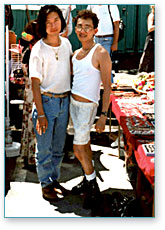Historically, the Chinese migrated through trade routes to various regions of Asia, and some settled permanently in Southeast Asia. Those who were traders and merchants used their entrepreneurial skills and global networks to set up businesses and trade a variety of goods. Others were involved in modest occupations such as fishing or farming. While some Chinese maintained distinct communities and kept their language and customs, others intermarried and were integrated into local communities. In North Vietnam, ethnic Chinese could retain their Chinese citizenship, but in the South, they were encouraged to become citizens to take advantage of economic benefits given to Vietnamese citizens.
After the Vietnam War, ethnic Chinese were persecuted in both Cambodia and Vietnam. Their economic prominence made them a target of the new Communist regime that wanted to nationalize the economy and eliminate private businesses, thus taking away their means of livelihood and accumulated wealth. At this point almost a quarter million ethnic Chinese resettled to the neighboring People's Republic of China. Others made their way to refugee camps in Macao and Hong Kong and then found their way to the United States. In the late 1970s, when border wars between China and Vietnam flared up, many ethnic Chinese were expelled from Vietnam and left as "boat people" refugees.

Most ethnic Chinese in the U.S. came from Vietnam, but some were from Cambodia and Laos. Rather than associate with other Southeast Asian American refugees, some preferred to identify with ethnic Chinese immigrants from other countries. They have revitalized dwindling Chinatown commercial areas or established businesses around the edges of communities of Chinese immigrants from mainland China, Taiwan, Hong Kong, and elsewhere. Ethnic Chinese are also credited with a percentage of the commercial development of Vietnamese and Cambodian American communities across the country. Some have intermarried and co-exist amicably within Southeast Asian American ethnic communities.
Due to historical animosity, cultural and social friction sometimes exists between ethnic Chinese and other Southeast Asians. Since they are often lumped together with Southeast Asian refugees and immigrants generally, limited documentation exists on the ethnic Chinese experience. One important example is the fact that U.S. Census data is unreliable for this group, since some consider themselves "Chinese," while others self-identity as Cambodian, Laotian, or Vietnamese. 
|


